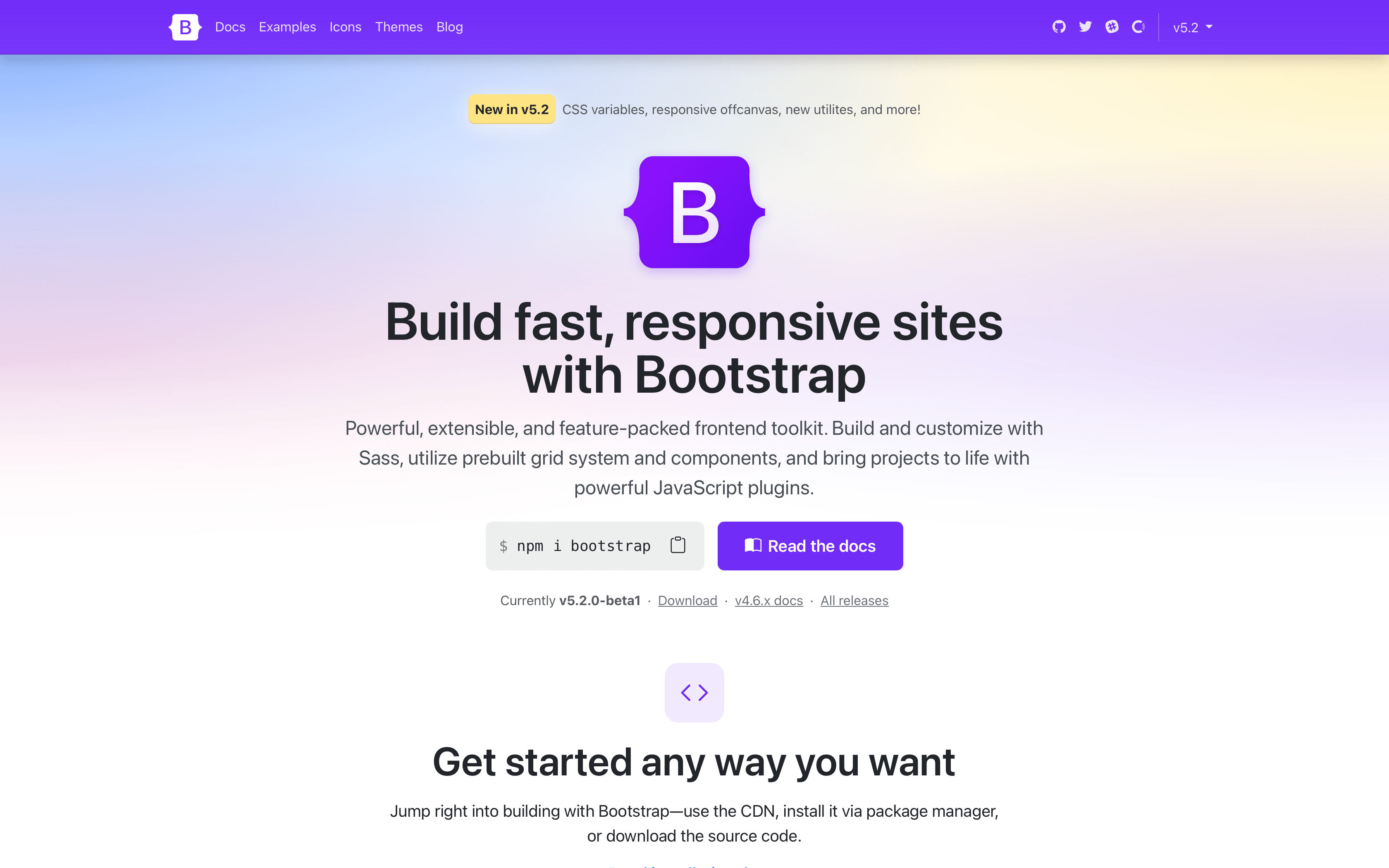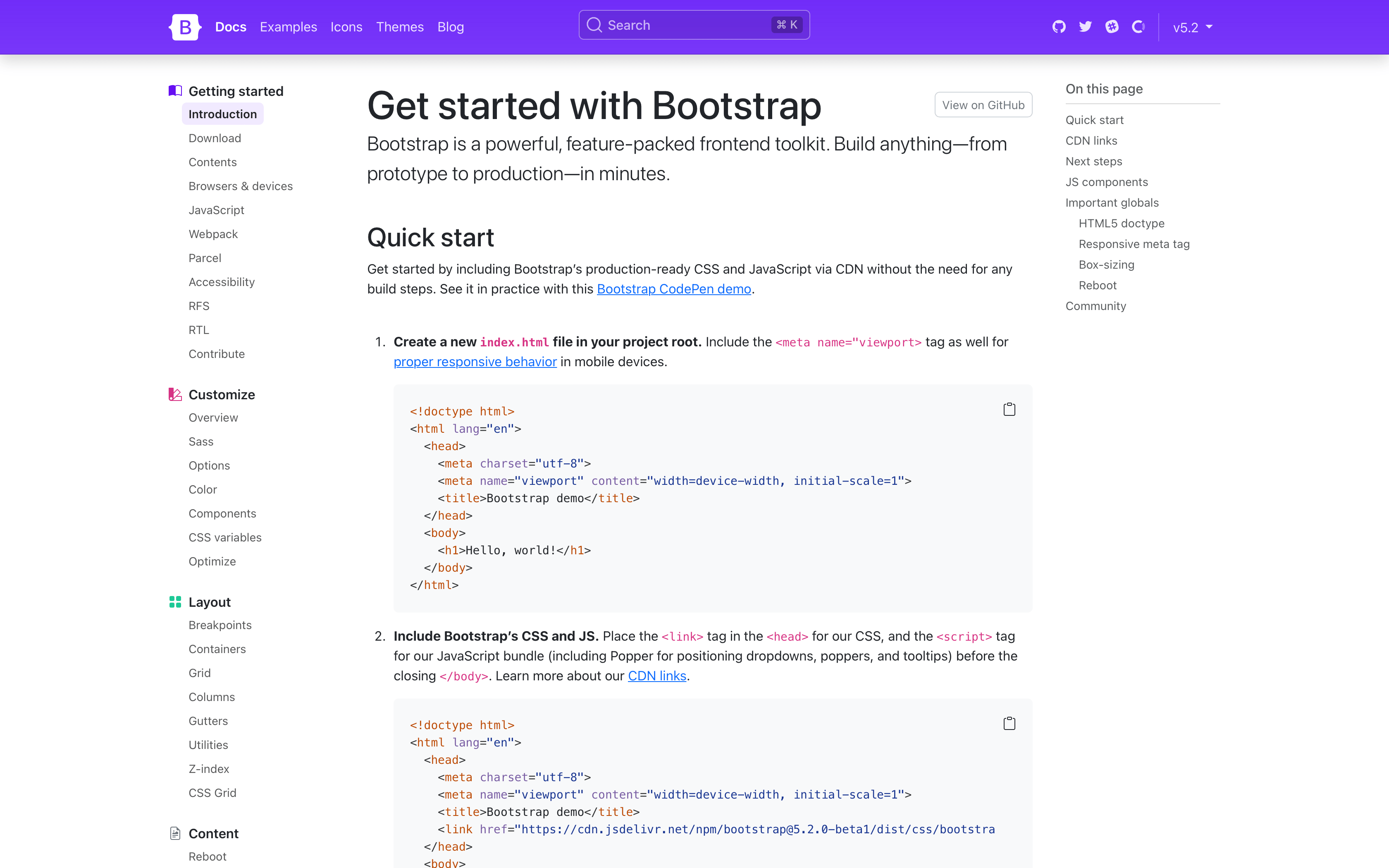- Details
- Category: Developer News
Ionic has been recognized as a high performer in continuous integration and continuous development categories, and leader in mobile development frameworks category in the summer quarter by G2—a peer-to-peer review site and software marketplace. Mobile development frameworks grid For multiple quarters in a row, Ionic has been recognized as a leader in the mobile development […]
The post Ionic Recognized by G2 appeared first on Ionic Blog.
Read more https://ionicframework.com/blog/ionic-recognized-by-g2/
- Details
- Category: Developer News
Ionic has been recognized as a high performer in continuous integration and continuous development categories, and leader in mobile development frameworks category in the summer quarter by G2—a peer-to-peer review site and software marketplace. Mobile development frameworks grid For multiple quarters in a row, Ionic has been recognized as a leader in the mobile development […]
The post Ionic Recognized as Top Leader in Mobile Development Frameworks appeared first on Ionic Blog.
Read more https://ionicframework.com/blog/ionic-recognized-by-g2/
- Details
- Category: Developer News
Bootstrap v5.2.0 is finally stable! We’ve ironed out more bugs, improved more documentation, written new guides and built out new functional environment examples, and so much more!
Keep reading for highlights from both beta and stable releases.
Docs redesign
As previewed in our beta release, the docs have been redesigned! It starts with our new homepage where we have a more complete representation of Bootstrap’s features and an updated design.
The docs sidebar navigation has been overhauled to have always expanded groups for easier browsing, a brand new DocSearch experience with search history, and new responsive offcanvas drawers for both sidebar and navbar on mobile.
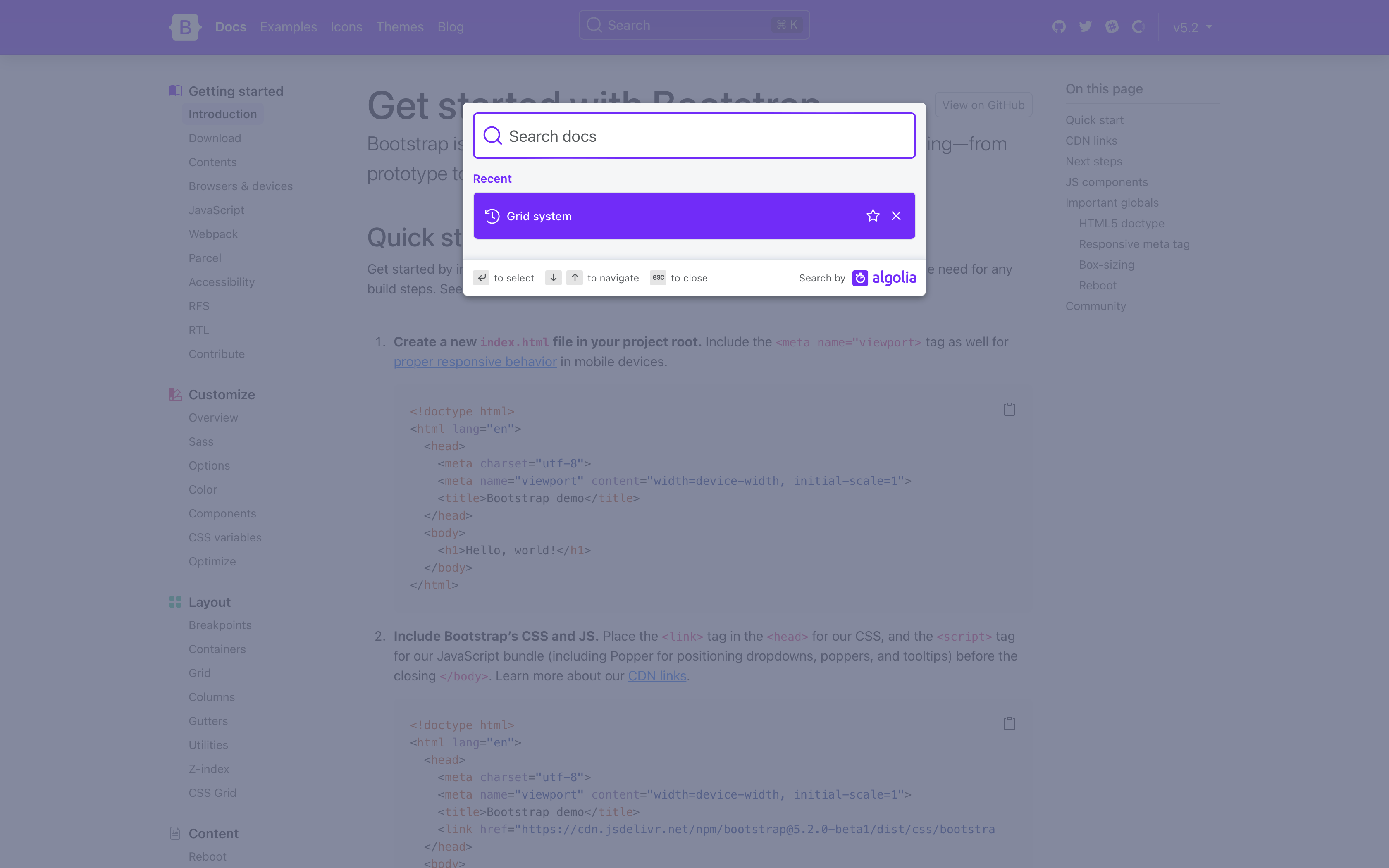
We even updated our version picker in the navbar to cross-link between minor releases!
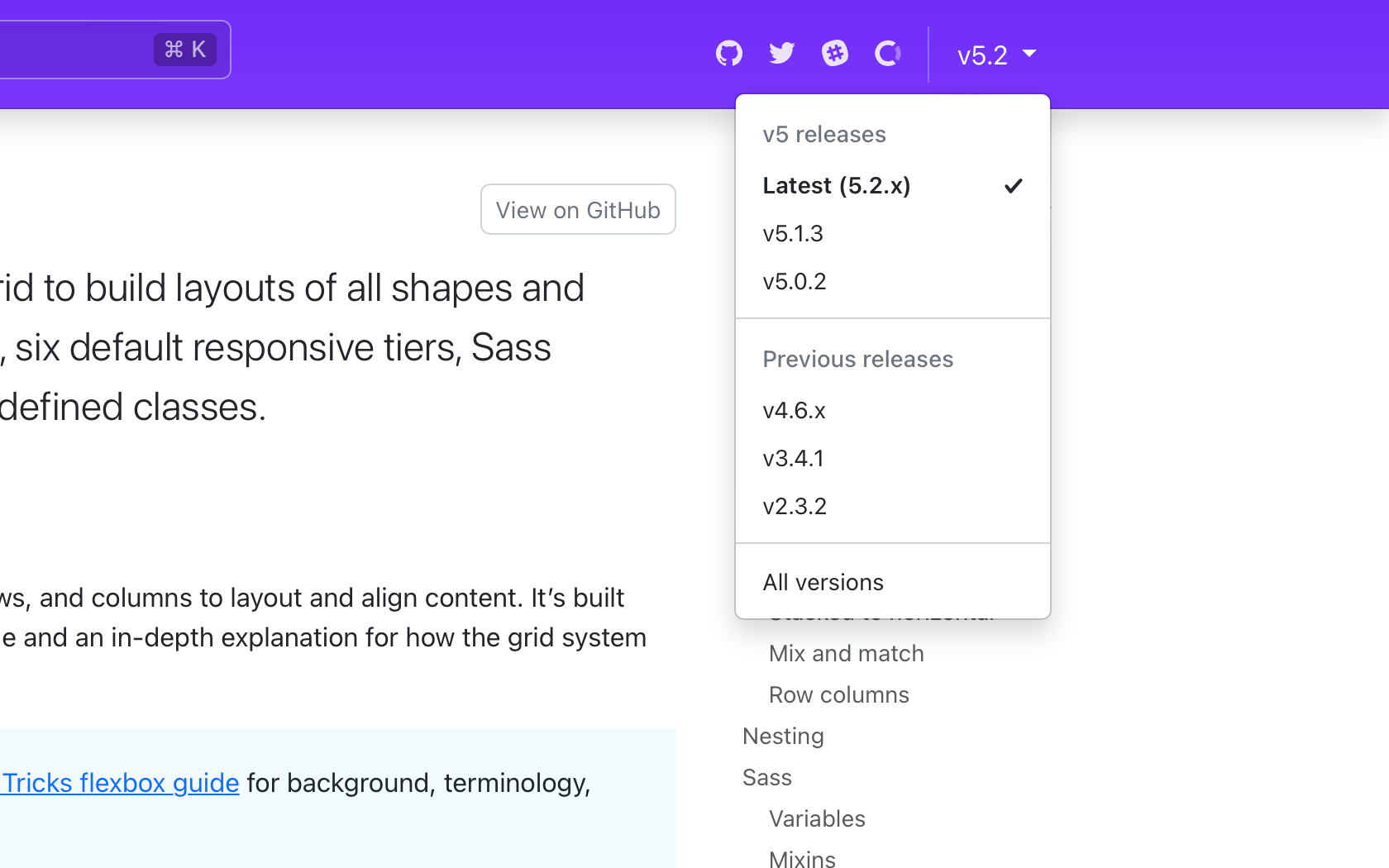
Updated buttons and inputs
With our docs redesign, we refreshed buttons and inputs with
modified padding and border-radius.
Here’s a look at the before and after of our buttons:

Tons of new CSS variables
Nearly all our components now have CSS variables for real real-time customization, easier theming, and (soon) color mode support starting with dark mode. You can see what CSS variables are available on every docs page, like our buttons:
--#{$prefix}btn-padding-x: #{$btn-padding-x};
--#{$prefix}btn-padding-y: #{$btn-padding-y};
--#{$prefix}btn-font-family: #{$btn-font-family};
@include rfs($btn-font-size, --#{$prefix}btn-font-size);
--#{$prefix}btn-font-weight: #{$btn-font-weight};
--#{$prefix}btn-line-height: #{$btn-line-height};
--#{$prefix}btn-color: #{$body-color};
--#{$prefix}btn-bg: transparent;
--#{$prefix}btn-border-width: #{$btn-border-width};
--#{$prefix}btn-border-color: transparent;
--#{$prefix}btn-border-radius: #{$btn-border-radius};
--#{$prefix}btn-box-shadow: #{$btn-box-shadow};
--#{$prefix}btn-disabled-opacity: #{$btn-disabled-opacity};
--#{$prefix}btn-focus-box-shadow: 0 0 0 #{$btn-focus-width} rgba(var(--#{$prefix}btn-focus-shadow-rgb), .5);
Values for virtually every CSS variables are assigned via Sass variable, so customization via CSS and Sass are both well supported. Also included for several components are examples of customizing via CSS variables.
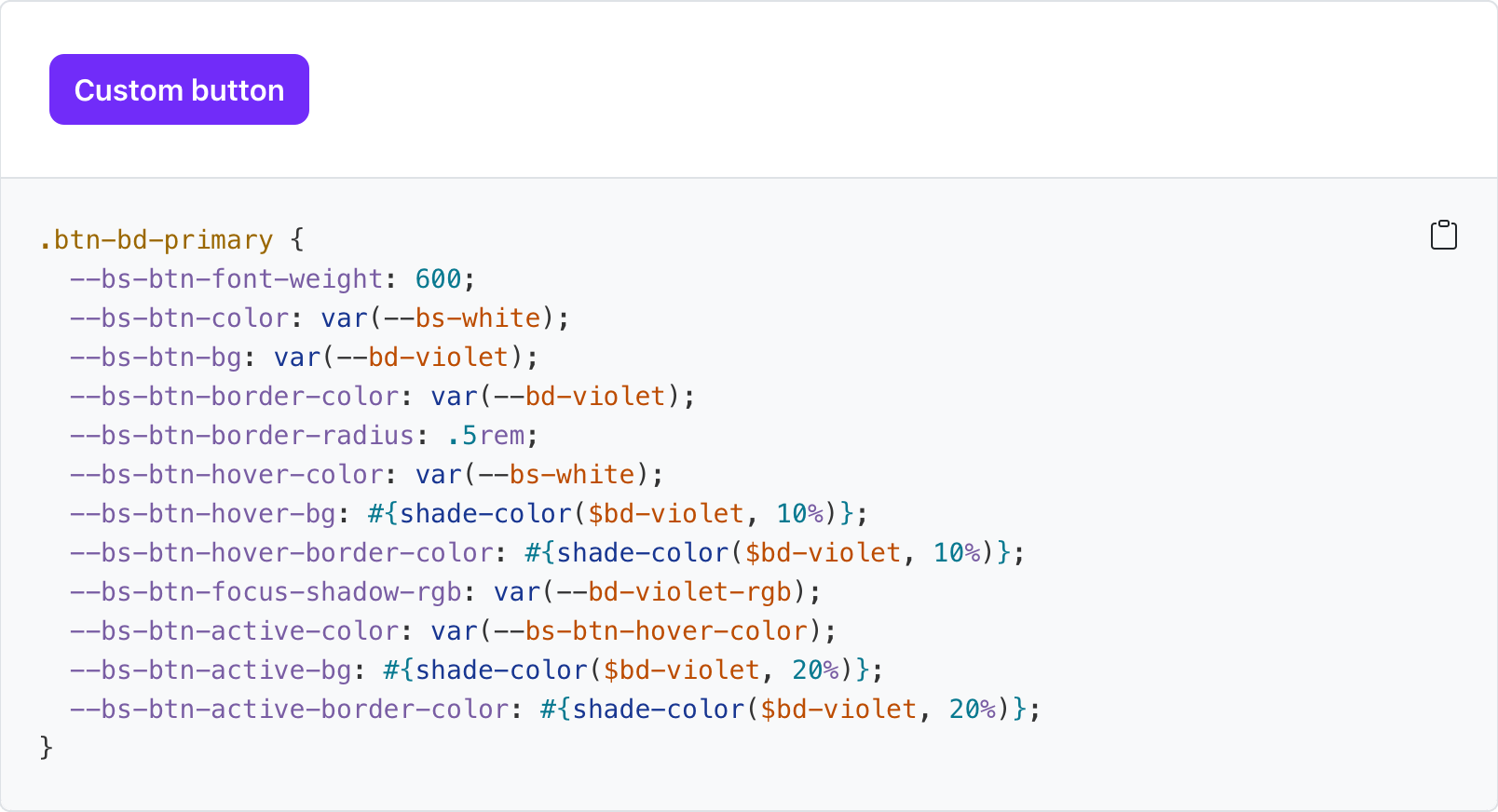
New _maps.scss
Bootstrap v5.2.0 introduced a new Sass file with
_maps.scss that pulls out several Sass maps from
_variables.scss to fix an issue where updates to an
original map were not applied to secondary maps that extend it.
It’s not ideal, but it resolves a longstanding issue for folks when
working with customized maps.
For example, updates to $theme-colors were not
being applied to other maps that relied on
$theme-colors (like the $utilities-colors
and more), which created broken customization workflows. To
summarize the problem, Sass has a limitation where once a
default variable or map has been used, it cannot be
updated. There’s a similar shortcoming with CSS
variables when they’re used to compose other CSS
variables.
This is also why variable customizations in Bootstrap have to
come after @import "functions";, but before
@import "variables"; and the rest of our import stack.
The same applies to Sass maps—you must override the defaults before
they get used. The following maps have been moved to the new
_maps.scss:
$theme-colors-rgb$utilities-colors$utilities-text$utilities-text-colors$utilities-bg$utilities-bg-colors$negative-spacers$gutters
Your custom Bootstrap CSS builds should now look like this with a separate maps import.
// Functions come first
@import "functions";
// Optional variable overrides here
+ $custom-color: #df711b;
+ $custom-theme-colors: (
+ "custom": $custom-color
+ );
// Variables come next
@import "variables";
+ // Optional Sass map overrides here
+ $theme-colors: map-merge($theme-colors, $custom-theme-colors);
+
+ // Followed by our default maps
+ @import "maps";
+
// Rest of our imports
@import "mixins";
@import "utilities";
@import "root";
@import "reboot";
// etc
New helpers and utilities
We’ve updated our helpers and utilities to make it easier to quickly build and modify custom components:
-
Added new
.text-bg-{color}helpers. Instead of setting individual.text-*and.bg-*utilities, you can now use the.text-bg-*helpers to set abackground-colorwith contrasting foregroundcolor. -
Expanded
font-weightutilities to include.fw-semiboldfor semibold fonts. -
Expanded
border-radiusutilities to include two new sizes,.rounded-4and.rounded-5, for more options.
Expect more improvements here as v5’s development continues.
Responsive offcanvas
Our Offcanvas component now has responsive variations. The original
.offcanvas class remains unchanged—it hides content
across all viewports. To make it responsive, change that
.offcanvas class to any
.offcanvas-{sm|md|lg|xl|xxl} class.
New Examples repo and guides
Since the beta, we’ve completely rewritten our Webpack guide and Parcel guide. We’ve also added a new Vite guide.
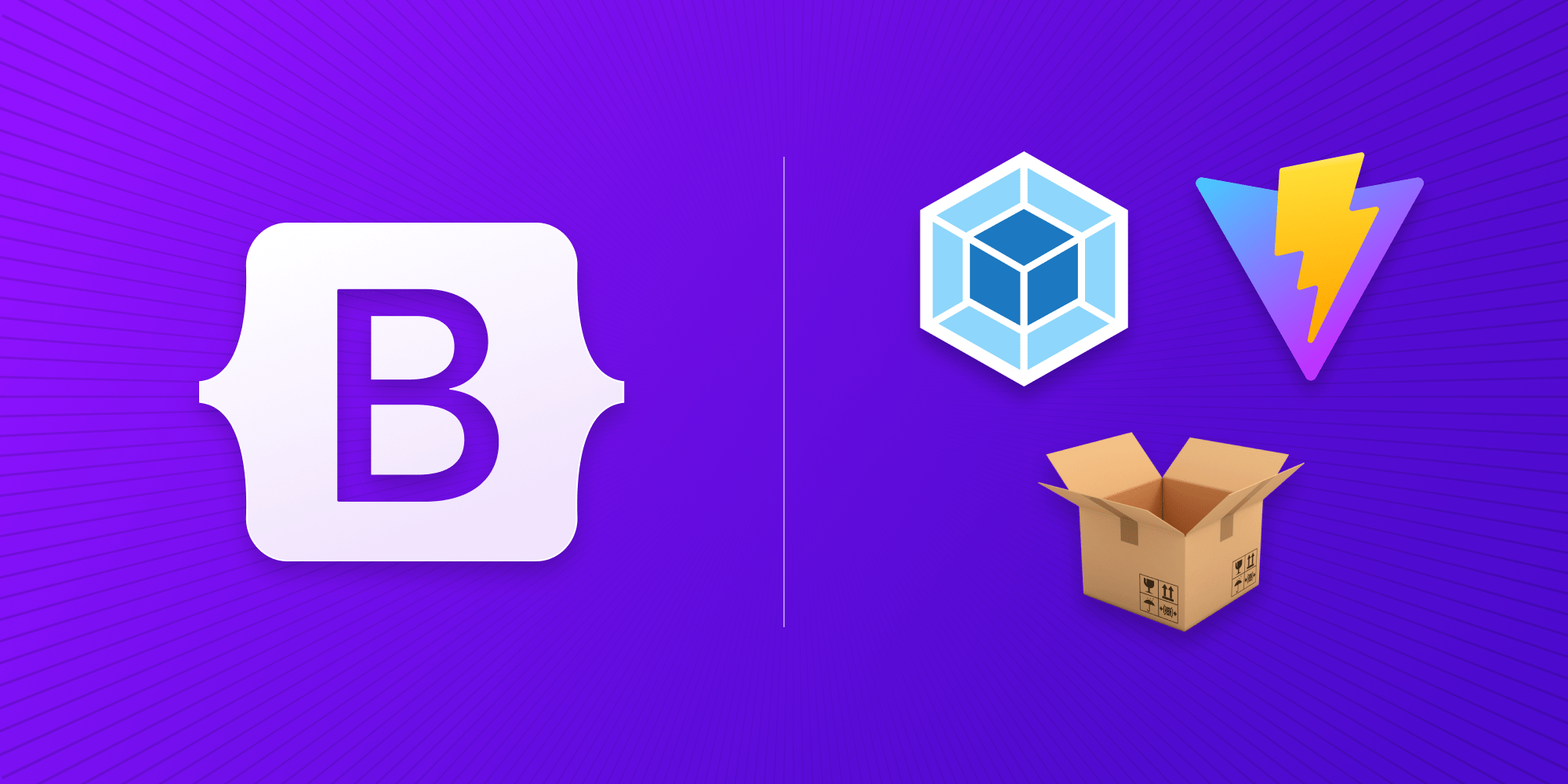
In addition, we’ve turned every one of those guides into a fully functioning example in our new twbs/examples repo. We’ve even added a couple more examples to the repo, with plans to create even more.
- Starter – CDN links for our CSS and JS
- Sass & JS — Import Sass, Autoprefixer, Stylelint, and our JS bundle via npm
- Sass & ESM JS — Import Sass, Autoprefixer, and Stylelint via npm, and then load our ESM JS with a shim
- Webpack - Import and bundle Sass and JS with Webpack
- Parcel - Sass, JS via Parcel
- Vite - Sass, JS via Vite
- Bootstrap Icons font - Import Bootstrap Icons via icon font
Each guide matches up to a new example in that repo, and nearly all of them can be immediately available in StackBlitz. Now you don’t even need to have a development environment configured on your computer to get started with Bootstrap.
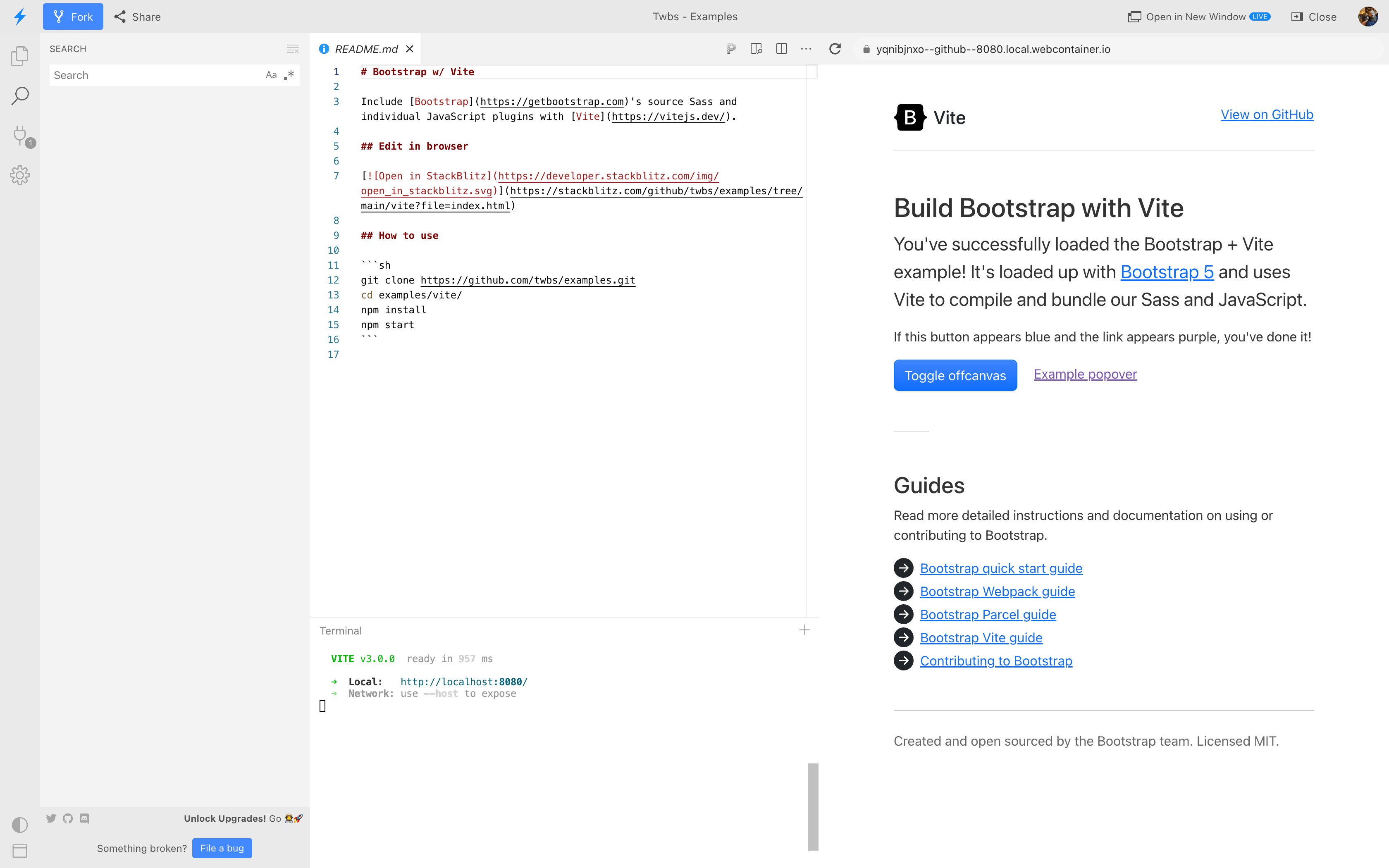
And did we mention that nearly all our code snippets now have an open in StackBlitz button?
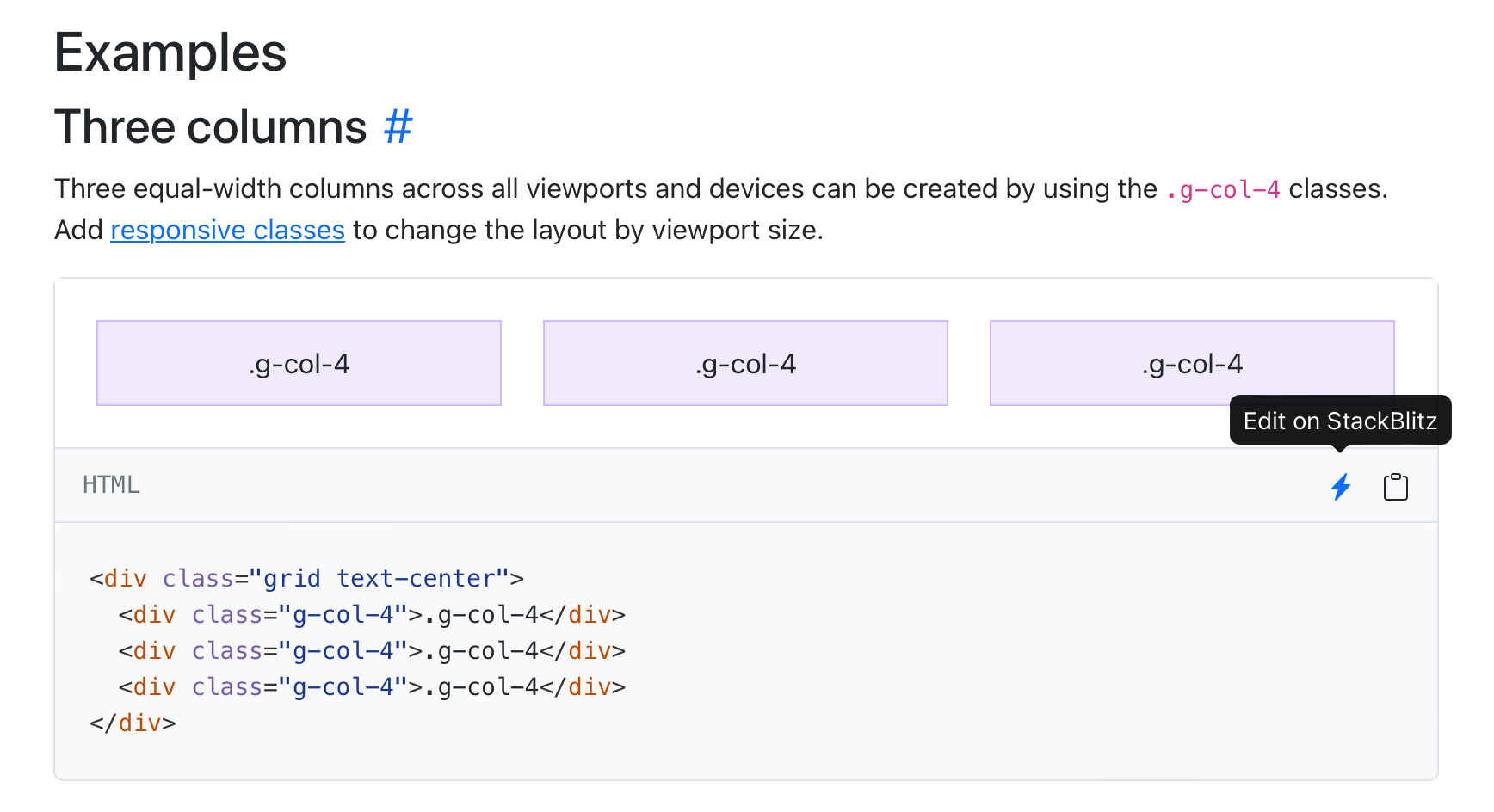
And more!
-
Introduced new
$enable-container-classesoption. — Now when opting into the experimental CSS Grid layout,.container-*classes will still be compiled, unless this option is set tofalse. Containers also now keep their gutter values. -
Thicker table dividers are now opt-in. — We’ve removed the thicker and more difficult to override border between table groups and moved it to an optional class you can apply,
.table-group-divider. See the table docs for an example. -
Scrollspy has been rewritten to use the Intersection Observer API, which means you no longer need relative parent wrappers, deprecates
offsetconfig, and more. Look for your Scrollspy implementations to be more accurate and consistent in their nav highlighting. -
Added
.form-check-reversemodifier to flip the order of labels and associated checkboxes/radios. -
Added striped columns support to tables via the new
.table-striped-columnsclass. -
Added a new experimental reserved data attribute
data-bs-configthat can house simple component configuration as a JSON string. -
Added new
smooth-scrollto Scrollspy.
Get the release
Head to https://getbootstrap.com for the latest. It’s also been pushed to npm:
npm i bootstrap@v5.2.0
Read the GitHub v5.2.0 changelog for a complete list of changes in this release.
Support the team
Visit our Open Collective page or our team members’ GitHub profiles to help support the maintainers contributing to Bootstrap.
Read more https://blog.getbootstrap.com/2022/07/19/bootstrap-5-2-0/
- Details
- Category: Developer News
After several months, we’ve finally shipped Bootstrap v4.6.2, one of our last releases for the v4. It’s a bit of a maintenance patch featuring bug fixes, dependency updates, and some docs updates.
Read on for the highlights or head to the v4.6.x docs to see the latest in action.
What’s changed
There are two big highlights in v4.6.2:
-
First, we’ve added an example to our Collapse plugin docs to show how to use horizontal collapsing. This has long been possible via our JS, but we never had an official class to utilize it.
-
Second, we’ve replaced the deprecated
color-adjustwithprint-color-adjustin our Sass files as part of the Autoprefixer v10.4.6 issues. This should quiet the issues folks have seen from that dependency change. If you’re using our distribution CSS files, likebootstrap.min.css, you may still see the warning.
Beyond that, we’ve addressed a few other things:
- Tweaked the size of
smalland.smallto compute to a whole pixel value (was12.8pxand now is14px). - Improved accessibility around our dropdowns, color contrast,
and
roleattributes. - Fixed some broken links to supporting documentation.
- Updated dependencies across the board.
Review the GitHub v4.6.2 release changelog for more details.
From here, we don’t expect to ship any meaningful updates to v4.6.x other than major security or dependency updates. Everything will focus on v5 and beyond after this release, starting with the stable release of v5.2.0. Bootstrap 4 will officially end of life January 1, 2023, though you’re obviously welcome to continue using it longer than that. Follow our release repo to stay in the loop on release maintenance status.
Support the team
Visit our Open Collective page or our team members’ GitHub profiles to help support the maintainers contributing to Bootstrap.
Read more https://blog.getbootstrap.com/2022/07/19/bootstrap-4-6-2/
- Details
- Category: Developer News
I’ve always found the Hybrid vs Native mobile debate a bit silly. Most native mobile apps mix Native UI controls and Web Views, including popular first-party apps built by Apple and Google. If this wasn’t such a common use case, the Web View component wouldn’t exist nor would it be so widely used. I often […]
The post Hybrid vs Native…What About a Third Option? appeared first on Ionic Blog.
Read more https://ionicframework.com/blog/hybrid-vs-native-what-about-a-third-option/
